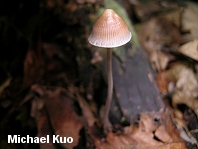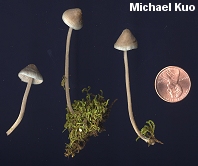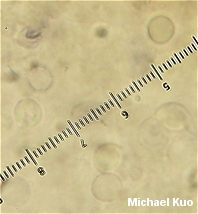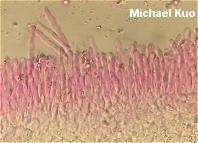| Major Groups > Gilled Mushrooms > Pale-Spored > Mycenoid Mushrooms > Mycena subcaerulea |

|
Mycena subcaerulea [ Basidiomycetes > Agaricales > Tricholomataceae > Mycena . . . ] by Michael Kuo When young and fresh, this beautiful Mycena is quite distinctive, sporting a blue cap and stem. Soon, however, the "sub" in its species name takes over, and the blue colors are relegated to the cap margin. Eventually Mycena subcaerulea is brownish overall, and all traces of blue disappear--at which point, if you have found it, you might as well give up on identifying it unless you want to spend hours with microscopes and monographs in a monotonous Mycena milieu. Mycena subcaerulea is one of the first species of Mycena to appear in central Illinois, and I occasionally find it even when hunting morels. As warmer weather ensues, Mycena subcaerulea makes a temporary disappearance, but returns in the fall. Mycena amicta is very similar, but grows on the deadwood of conifers and is distributed primarily in western North America. Under the microscope it has elliptical, rather than subglobose, spores. Mycena cyaneobasis is a synonym. Description: Ecology: Saprobic on the deadwood or woody debris of hardwoods, especially oaks; growing alone or scattered, often on or near stumps; spring and again in fall; widely distributed east of the Great Plains. Cap: Up to 2 cm across; conical when young, becoming broadly conical or bell-shaped; moist; smooth or with a grainy dusting near the margin; blue when very young and fresh, but soon brown to grayish brown with a bluish margin; the margin usually lined. Gills: Attached to the stem; close or crowded; whitish or pale grayish. Stem: 3-8 cm long; 1-2 mm thick; fragile; equal; hollow; finely fuzzy; bluish near the apex at first, but soon grayish to brownish overall; basal mycelium blue but soon white. Flesh: Insubstantial; pallid or grayish. Odor and Taste: Not distinctive. Spore Print: White. Microscopic Features: Spores 6-8 x 6-7 µ; weakly to moderately amyloid, or inamyloid when mature; subglobose; smooth. Pleurocystidia absent. Cheilocystidia abundant; 32-60 µ long; cylindric and flexuous, or nearly spindle-shaped. Pileipellis an ixotrichoderm. REFERENCES: (Peck, 1873) Saccardo, 1887. (Kauffman, 1918; Smith, 1947; Smith, Smith & Weber, 1979; Lincoff, 1992; Barron, 1999; McNeil, 2006.) Herb. Kuo 05180401, 05110701, 05281001. This site contains no information about the edibility or toxicity of mushrooms. |
© MushroomExpert.Com |
|
Cite this page as: Kuo, M. (2010, December). Mycena subcaerulea. Retrieved from the MushroomExpert.Com Web site: http://www.mushroomexpert.com/mycena_subcaerulea.html |



